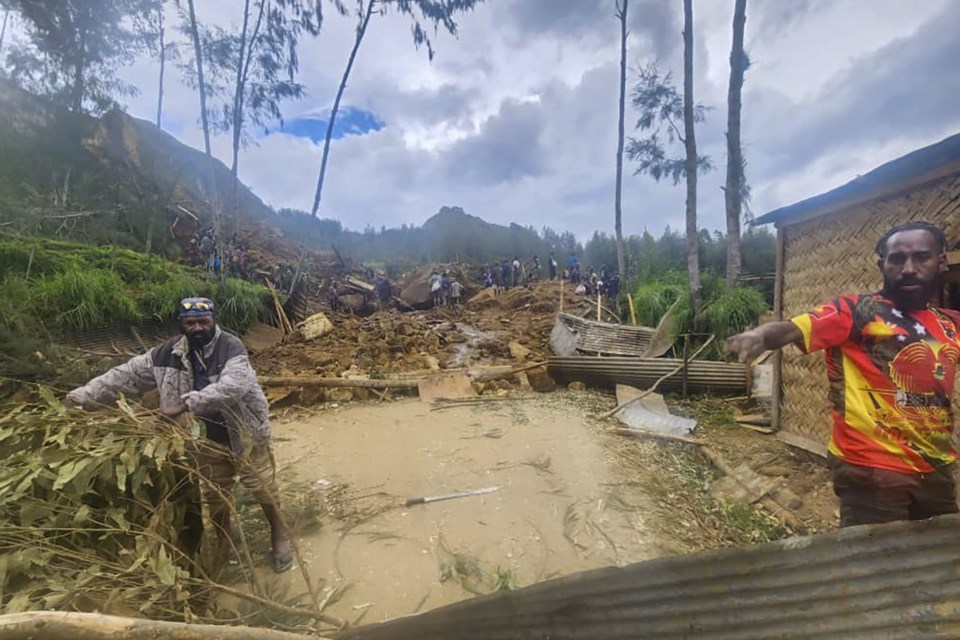MELBOURNE, Australia (AP) — A Papua New Guinea government official has told the United Nations more than 2,000 people were believed to have been buried alive by Friday's and has formally asked for international help.
The government figure is roughly triple the U.N. estimate of 670 killed by the landslide in the СŔ¶ĘÓƵ Pacific island nation's mountainous interior. The remains of only six people had been recovered so far.
In a letter seen by The Associated Press to the United Nations resident coordinator dated Sunday, the acting director of the СŔ¶ĘÓƵ Pacific island nation’s National Disaster Center Luseta Laso Mana said the landslide “buried more than 2000 people alive” and caused “major destruction” at Yambali village in the Enga province.
Estimates of the casualties have varied widely since the disaster occurred, and it was not immediately clear how officials arrived the number of people affected.
The International Organization for Migration, which is working closely with the government and taking a leading role in the international response, has not changed its estimated death toll of 670 released on Sunday, pending new evidence.
“We are not able to dispute what the government suggests but we are not able to comment on it," said Serhan Aktoprak, the chief of the U.N. migrant agency's mission in Papua New Guinea.
“As time goes in such a massive undertaking, the number will remain fluid,” Aktoprak added.
The death toll of 670 was based on calculations by Yambali village and Enga provicincial officials that more than 150 homes had been buried by the landslide. The previous estimate had been 60 homes.
The office of Papua New Guinea Prime Minister James Marape did not respond Monday to a request for an explanation of what the government estimate of 2,000 was based on.
Determining the scale of the disaster is difficult because of challenging conditions on the ground including the village's remote location, a lack of telecommunications and tribal warfare throughout the province which means international relief workers and aid require military escorts.
The landslide had also buried a 200-meter (650-foot) stretch of the province's main highway under debris 6 to 8 meters (20 to 26 feet) deep which creates a major obstacle to relief workers.
Mana said the landslide would have a major economic impact on the entire country.
"The situation remains unstable” due to the shifting ground, “posing ongoing danger to both the rescue teams and survivors alike,” Mana wrote to the United Nations.
An excavator donated by a local builder Sunday became the first piece of heavy earth-moving machinery brought in to help villagers who have been digging with shovels and farming tools to find bodies. Working around the still-shifting debris is treacherous.
Mana and Papua New Guinea's defense minister, Billy Joseph, flew on Sunday in an Australian military helicopter from the capital of Port Moresby to Yambali, 600 kilometers (370 miles) to the northwest, to gain a firsthand perspective of what is needed.
Mana’s office posted a photo of him at Yambali handing a local official a check for 500,000 kina ($130,000) to buy emergency supplies for the 4,000 displaced survivors.
The purpose of the visit was to decide whether Papua New Guinea's government needed to officially request more international support.
Earth-moving equipment used by Papua New Guinea's military was СŔ¶ĘÓƵ transported to the disaster scene 400 kilometers (250 miles) from the east coast city of Lae.
Traumatized villagers are divided over whether heavy machinery should be allowed to dig up and potentially further damage the bodies of their buried relatives, officials said.
___
Associated Press journalist Adam Schreck in Bangkok contributed to this report.
Rod Mcguirk, The Associated Press




